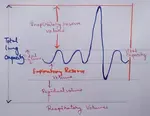External Organs
The external organs of our body are eyes, ears, nose, tongue and skin. We can see these organs.
These external organs are our sense organs. Sense organs are important parts of our body because they tell us about our surroundings.
Stand in front of a mirror. Observe our body parts. Our body is made up of many parts. These body parts can be grouped as follows:
Head: Turn your head sideways. Let’s raise our head up and down. We can do these movements due to the neck. Now let us note the other features of our head and their functions.
Neck: The neck rests on the shoulders. Below the shoulders lies the chest, stomach, waist, back and hips. Suppose to pick up a fallen pencil, we need to bend at our waist to pick up the pencil from the floor. We can bend in front, sideways and little at the back.
Arms and legs:
Let’s hold a pencil with our fingers. Swing our arms. Bend our arm at the
elbow. Bend down. Jump up and down. Now let us note which external parts of your body move freely and
also note the functions which can be performed by the external body parts.
Every human being has similar body parts. Yet, we look different from one another. Why?
The shape and size of the body parts differ from person to person. This makes us look different from one another. Thus, even in a crowded room, we can spot our friend easily. The differences in external body features, the height and build of the body make us different from one another. These differences help u to recognize one another.
Teeth and its ImportanceFrom External Organs to HOME PAGE
Recent Articles
-
Regulation of Respiration | Respiratory Centres | Inspiratory Area |
Oct 14, 25 12:13 AM
Respiratory Centre is the area that controls the rate of respiration and it is observed to be located in medulla oblongata and pons. Respiratory Centre has the following will dispersed components like… -
Explain Transport of Gases | External Respiration | Tissue Respiration
Oct 09, 25 11:35 PM
In humans gaseous exchange is completed in the following ways the steps are - External Respiration or Breathing - Breathing in false taking in of Oxygen and giving out of carbon dioxide in the body. M… -
Kind and Number of Teeth | Location of Teeth in Mouth | Care of Teeth
Sep 11, 25 12:52 AM
Kind and Number of Teeth -
The Gaseous Exchange | Transport of Oxygen | Haldane Effect |
Sep 10, 25 02:44 PM
Oxygen carrying capacity of blood is 20 ml for 100m but 3% of dissolved in plasma and 97% of the oxygen combines with haemoglobin to form a loose reversible Complex called oxyhaemoglobin and is transp… -
Respiratory Volumes and Capacities | Tidal Volume | Dead Space
Sep 10, 25 02:46 AM
Explain respiratory volumes and capacities: Tidal Volume - Tidal volume is the volume of air inspired or expired in relaxed or resting position. Amount of tidal volume is about 500 m and it consists o…






New! Comments
Have your say about what you just read! Leave me a comment in the box below.